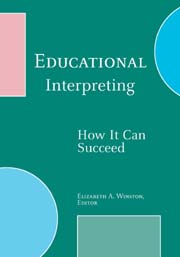How It Can Succeed
Elizabeth A. Winston, Editor
|
View the table of contents. View the list of contributors. Read an excerpt. Read reviews: The Midwest Book Review, The Sign Language Translator and Interpreter. |
$80.00s print edition $80.00 e-book |
This text has been replaced by Advances in Educational Interpreting.
From The Sign Language Translator and Interpreter, cont’d.
The second chapter, written by Christine Monikowski, is a review of the literature on first language acquisition and second language learning of deaf students, concluding with a discussion of the ‘mythical role of interpreter as language model” (p. 49). Monikowski explores the challenges facing a deaf child in acquiring a first language (LI), particularly if born into a hearing family. She notes that the vast majority of educational interpreters are second language (L2) users of American Sign Language (ASL) who are not proficient in ASL nor certified to practice as interpreters. Monikowski argues that the notion of the interpreter as a language role model for deaf children from hearing families is thus ill-conceived, particularly given the often poor LI foundation of the child. The potential for language deficit for these deaf children is significant.
In chapter three, Kelly Stack addresses the efficacy of English influenced signing systems. After a literature review, Stack presents a single longitudinal case study (covering 14 months) of ‘Jamie’, a 4 year old deaf child whose hearing parents are skilled users of Signing Exact English (SEE). Jamie demonstrated linguistic gaps and grammatical innovations indicative of the inability of SEE to provide her with normal language acquisition. Stack’s data is revealing because, given Jamie’s relatively early exposure to SEE in the home from the age of 11 months, the deficits in her acquisition of language can be more easily attributed to the inadequacy of SEE, rather than the off-cited variable of a critical language learning period.
The final chapter in this part of the volume is by Brenda Schick, tackling the issue of the cognitive development of deaf students in an interpreted education environment. She discusses the development of Theory of Mind (the cognitive ability to understand others’ intentions and perspectives) and also addresses Vygotsky’s Zone of Proximal Development (the gap between a learner’s actual development and their level of potential development). Schick notes that educational interpreters are often unable to adequately convey register shifts, discourse markers and prosody, which potentially impacts on the development of Theory of Mind in deaf children. In addition, the interpreters’ lack of awareness of the Zone of Proximal Development assumed by the classroom teacher may impact on their interpretation. Schick cautions, if the interpreter does not understand the learning process, it is very difficult to channel information correctly to the deaf student, even if the interpreter is very competent.
The first chapter in the second part reports on a qualitative research study, drawing 19 participants from an educational interpreters’ internet forum, conducted by Elizabeth Caldwell Langer. The main issues raised concerned identity and role formation, communication breakdowns and control over positioning and space in the classroom. The chapter contains specific suggestions from the interpreter participants directed at fellow interpreters, teachers and administrators. The internet discussion forum that participants were drawn from is reported as a highly valuable tool for educational interpreters, as a ‘place’ to discuss issues and share experiences and to gain support from colleagues.
The next chapter is authored by Bernhardt E. Jones and is a literature based review of the two main issues he identifies for educational interpreters, namely the qualifications of kindergarten, primary and secondary school (K-12) interpreters and the roles and responsibilities of these practitioners. A profile of the average educational interpreter is described, and statistical data on interpreter demographics and qualifications from 1993 and 2001 are compared. Jones laments the lack of qualified practitioners in the field, noting that, while it would be unacceptable to consider placing an unqualified teacher at the front of the classroom, ill-equipped and poorly skilled interpreters deliver an interpreted education to many deaf students on a daily basis. Jones notes that inclusion is effectively a myth when students are so poorly resourced and recommends the widespread use of the Educational Interpreter Performance Assessment (EIPA) for evaluating interpreter competence.
Elizabeth A. Winston is the director of the Teaching Interpreting Educators and Mentors (TIEM) Center in Loveland, CO, where she directs research into interpreter education practices, discourse analysis, assessment, and evaluation.
Print Edition: ISBN 978-1-56368-309-1, 7 x 10 casebound, 240 pages, 13 tables, 8 figures
$80.00s
E-Book: ISBN 978-1-56368-281-0
$80.00
